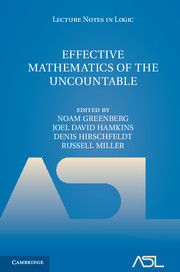Book contents
- Frontmatter
- Contents
- Preface
- Introduction
- Some results on ℝ-computable structures
- Infinite time Turing machines and an application to the hierarchy of equivalence relations on the reals
- Computable structure theory using admissible recursion theory on ω1 using admissibility
- Local computability and uncountable structures
- Borel structures: a brief survey
- E-recursive intuitions
- Reverse mathematics, countable and uncountable: a computational approach
- Effective model theory: approach via σ-definability
- References
Introduction
Published online by Cambridge University Press: 05 December 2013
- Frontmatter
- Contents
- Preface
- Introduction
- Some results on ℝ-computable structures
- Infinite time Turing machines and an application to the hierarchy of equivalence relations on the reals
- Computable structure theory using admissible recursion theory on ω1 using admissibility
- Local computability and uncountable structures
- Borel structures: a brief survey
- E-recursive intuitions
- Reverse mathematics, countable and uncountable: a computational approach
- Effective model theory: approach via σ-definability
- References
Summary
Chang and Keisler [8] famously defined model theory as the sum of logic and universal algebra. In the same spirit, one might describe computable model theory to be the investigation of the constraints on information content imposed by algebraic structure. The analogue of the interplay between syntactical objects and the algebraic structure they deine is the connection between deinability and complexity. One asks: How complicated are the constructions of model theory and algebra? What kind of information can be coded in structures like groups, ields, graphs, and orders? What mathematical distinctions are unearthed when “boldface” notions such as isomorphism are replaced by their “lightface” analogues such as, say, computable isomorphism?
A special case of the following definition was first rigorously made by Fröhlich and Shepherdson [11], following work of Hermann [17] and van der Waerden [40], which itself built on the constructive tradition of 19th century algebra. It was further developed by Rabin [32, 33] and Mal'cev [27].
Definition. Let ℒ be a computable signature (language), and let ℳ be an ℒ-structure whose universe is the set of natural numbers. The degree of ℳ is the Turing degree of the atomic (equivalently, quantifier-free) diagram of ℳ.
A structure is computable if its degree is 0, the Turing degree of computable sets. Equivalently, a structure ℳ is computable if, uniformly in the symbols of ℒ, the interpretations in ℳ of the constant symbols, function symbols, and relation symbols of ℒ are computable.
- Type
- Chapter
- Information
- Effective Mathematics of the Uncountable , pp. 1 - 13Publisher: Cambridge University PressPrint publication year: 2013



